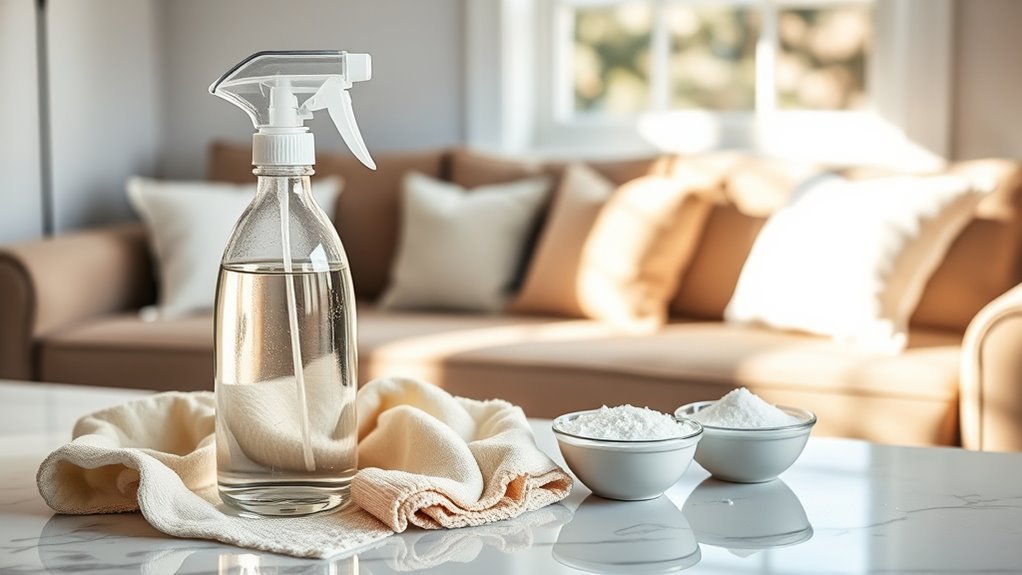How to Make Homemade Couch Cleaner
To make a homemade couch cleaner, combine one cup of water, half a cup of white vinegar, and a tablespoon of mild dish soap in a spray bottle. Shake gently to mix. Before cleaning, vacuum and spot-test a hidden area to avoid damage. Use the solution to blot stains lightly without soaking, and sprinkle baking soda on grease spots first. This approach is safe, effective, and affordable—explore further tips for different fabrics and stain types to keep your couch fresh and spotless.
Essential Ingredients for Homemade Couch Cleaner

To make an effective homemade couch cleaner, you’ll need a few essential ingredients that are safe and easy to find. Start with white vinegar, a powerful natural cleaning agent that breaks down dirt and removes odors without harsh chemicals. Add baking soda, which acts as a gentle abrasive to lift stains and freshen fabric. Liquid castile soap provides a mild but effective cleansing action, perfect for delicate upholstery. For a pleasant scent, include a few drops of essential oils like lavender or tea tree, both known for their antibacterial properties. Finally, water serves as the solvent to blend these ingredients smoothly. These natural cleaning components combine in homemade recipes to give you a simple, eco-friendly alternative, granting you freedom from commercial cleaners loaded with toxins.
Preparing Your Couch for Cleaning
Before applying any cleaner, you’ll want to thoroughly prepare your couch to guarantee the best results. Start with a careful couch inspection, checking for stains, tears, or fragile areas. Remove all cushions and vacuum the surface to clear dust and debris. Next, perform fabric testing on a small, hidden section of the couch. Apply a bit of your homemade cleaner and wait a few minutes to confirm it doesn’t cause discoloration or damage. This step protects your fabric and keeps your couch looking fresh without risking harm. Once the fabric testing is successful, you’re ready to proceed confidently. Taking these preparatory steps confirms your cleaning process is effective, safe, and prolongs your couch’s life, giving you the freedom to enjoy a spotless living space.
Step-by-Step Guide to Mixing Your Cleaner

With your couch ready and fabric tested, you can start mixing your homemade cleaner. Begin by measuring your ingredients carefully to maintain proper cleaning ratios—typically, one cup of water, half a cup of white vinegar, and a tablespoon of mild dish soap. Use a clean spray bottle or bowl for mixing.
Pour liquids slowly, combining them gently to avoid excessive suds. Stir or shake the mixture thoroughly to blend the solution evenly. Avoid overmixing, which can reduce effectiveness.
Techniques for Removing Common Couch Stains
Although removing stains from your couch can seem challenging, tackling them quickly and correctly makes a big difference. Understanding stain types helps you apply the right technique without delay. Remember, consistent cleaning frequency prevents buildup and keeps your couch fresh.
Act fast and clean regularly to prevent stains from setting and keep your couch looking fresh.
Here’s how to handle common stains effectively:
- Food and drink spills: Blot immediately with a clean cloth, then apply your homemade cleaner gently.
- Oil and grease: Sprinkle baking soda to absorb excess oil before using a mild detergent solution.
- Ink or dye: Dab with rubbing alcohol carefully, avoiding spreading the stain.
Act fast and adapt based on the stain type. Regular cleaning frequency not only preserves your couch but also gives you freedom from stubborn marks.
Tips for Cleaning Different Couch Fabrics

Since each couch fabric reacts differently to cleaning agents and methods, knowing how to treat them properly is key to avoiding damage. For delicate fabric types like silk or velvet, use a gentle, water-free solvent or test a mild homemade cleaner on a hidden area first. Microfiber and synthetic fabrics tolerate water-based cleaning methods well; a mixture of mild soap and water works great. Leather requires special care—avoid harsh chemicals and opt for a conditioner-based cleaner or a vinegar and water solution. Always check your couch’s care label to select the best cleaning method. Avoid soaking fabrics, and use soft cloths or brushes to prevent abrasion. Tailoring your approach to each fabric type guarantees effective cleaning without compromising your couch’s integrity or your freedom to enjoy it.
How to Deodorize Your Couch Naturally
You can naturally deodorize your couch using simple ingredients like baking soda, essential oils, and vinegar. Sprinkle baking soda to absorb odors, then add a few drops of essential oils for a fresh scent. A light vinegar spray can also neutralize smells without damaging the fabric.
Essential Oils Benefits
When you want to refresh your couch without harsh chemicals, essential oils offer a natural and effective solution. They not only neutralize odors but also bring aromatherapy benefits, creating a calming environment with natural fragrances. You can easily customize your couch cleaner by choosing oils that match your mood and style.
Here’s why essential oils work great for deodorizing your couch:
- Promote relaxation and stress relief through aromatherapy benefits.
- Provide long-lasting natural fragrances without synthetic additives.
- Offer antibacterial properties to help maintain a fresh, clean surface.
To use, simply add a few drops of your favorite essential oil to your homemade cleaner or spray mixture. This way, you enjoy a fresh-smelling couch and the freedom of a toxin-free living space.
Baking Soda Method
One simple way to naturally deodorize your couch is by using baking soda. Thanks to its odor-absorbing properties, baking soda benefits your couch by neutralizing unpleasant smells without harsh chemicals. To apply, sprinkle a generous layer of baking soda evenly over the couch surface, focusing on areas prone to odors. Let it sit for at least 15-30 minutes—longer if possible—to maximize its deodorizing effect. Afterward, vacuum thoroughly to remove all residue. This method is one of the easiest baking soda applications for freshening upholstery, giving you a clean, odor-free couch effortlessly. Baking soda is safe, affordable, and effective, making it a must-have in your natural cleaning toolkit. Use it regularly to keep your living space smelling fresh and free.
Vinegar Spray Usage
Two key ingredients—water and white vinegar—combine to create an effective natural deodorizer for your couch. Vinegar benefits include neutralizing odors and breaking down grime without harsh chemicals. To use, mix equal parts water and white vinegar in a spray bottle. Lightly mist your couch and let it air dry. If vinegar’s scent bothers you, try these vinegar alternatives:
- Lemon juice diluted with water for a fresh citrus aroma
- Witch hazel mixed with water for gentle deodorizing
- Essential oils added to vinegar spray to mask strong odors
This method gives you control over what touches your couch, aligning with your desire for freedom from synthetic cleaners. Always test a small area first to verify fabric safety. Your couch stays fresh, naturally.
Best Practices for Maintaining a Clean Couch
To keep your couch looking fresh, vacuum it regularly to remove dust and crumbs before they settle in. Act quickly with spot cleaning to prevent stains from setting, using gentle homemade solutions. Also, practice preventive care by avoiding eating on the couch and rotating cushions to maintain even wear.
Regular Vacuuming Techniques
Vacuuming your couch at least once a week helps prevent dust, dirt, and crumbs from embedding into the fabric. To get the best results, focus on maximizing your vacuum’s suction power and using the crevice tool to reach tight spaces.
Here’s how to keep your couch fresh and clean:
- Use the crevice tool to remove debris from seams and under cushions.
- Adjust suction power based on fabric type—lower for delicate materials, higher for sturdy ones.
- Vacuum all surfaces thoroughly, including the back and sides, to prevent buildup.
Regular vacuuming saves you time and effort later, maintaining your freedom from stubborn dirt. Stick to this routine, and your couch will stay inviting and clean longer without harsh chemicals.
Spot Cleaning Tips
Keeping your couch free from dust and crumbs lays the foundation for more targeted cleaning when stains appear. For effective spot cleaning strategies, act quickly. Blot spills immediately with a clean cloth, avoiding rubbing that pushes stains deeper. Use your homemade couch cleaner sparingly on the stained area, testing first on a hidden spot to verify fabric safety. Apply stain removal techniques by gently dabbing the solution, letting it sit briefly, then blotting again to lift the stain. Repeat only if necessary. Avoid saturating the fabric to prevent damage. Once treated, let the area air dry fully before use. By mastering these precise spot cleaning strategies, you maintain your couch’s appearance and extend its life, giving you the freedom to enjoy a fresh, inviting space without hassle.
Preventive Care Measures
Although occasional deep cleaning is essential, consistent preventive care will save you time and effort in the long run. Protecting your couch starts with proactive habits that maintain fabric integrity and appearance. Applying a suitable fabric treatment not only repels spills but also extends the life of your upholstery. For effective couch protection, incorporate these best practices:
- Use washable slipcovers or throws to shield your couch from dirt and stains.
- Regularly vacuum to remove dust and prevent fabric wear.
- Apply a fabric treatment spray every few months to create a protective barrier.
Frequently Asked Questions
Can Homemade Couch Cleaner Be Used on Leather Couches?
You can use homemade couch cleaner on leather couches, but you’ve got to be careful. Leather care requires gentle cleaning solutions that won’t damage the finish or dry out the material. Avoid harsh ingredients like vinegar or baking soda. Instead, opt for a mild soap mixed with water and test it on a hidden spot first. This way, you keep your leather looking great without sacrificing freedom from harsh chemicals.
How Often Should I Deep Clean My Couch?
Think of your couch as a loyal ship sailing through daily storms of dust and spills. To keep it seaworthy, follow frequency recommendations and deep clean every 6 to 12 months. This cleaning schedule frees you from stubborn stains and lingering odors, ensuring smooth sailing. If you have pets or kids, consider more frequent cleanings—every 3 to 6 months—to keep your comfy vessel in top shape and your freedom to relax uninterrupted.
Are Homemade Cleaners Safe for Pets and Children?
You’ll want to prioritize pet safety and child safety when using homemade cleaners. While many DIY solutions use natural ingredients, some can still irritate sensitive skin or cause allergies. Always test a small area first and keep pets and kids away until the couch is completely dry. Avoid harsh substances like vinegar or essential oils that might be harmful. By taking these steps, you’ll keep your space safe and fresh without worry.
Can I Store Leftover Homemade Cleaner for Later Use?
Yes, you can store leftover homemade cleaner for later use. For best results, keep it in a sealed, airtight container away from direct sunlight and extreme temperatures. This helps maintain the cleaner’s effectiveness. Typically, your cleaner’s shelf life is about one to two weeks. Always label your container with the date you made it, so you know when it’s time to make a fresh batch. Following these storage tips keeps your cleaner ready when you need it.
What Should I Do if the Cleaner Causes Discoloration?
Discoloration causes frustration, yet it opens doors to color restoration. First, stop using the cleaner immediately. Blot the area gently with a damp cloth to remove residue. Test a mild detergent diluted in water on a hidden spot before applying it to the discolored area. If the stain persists, consider using a fabric-safe color restorer or consult a professional. Taking swift action helps you regain your couch’s original freedom of color.






